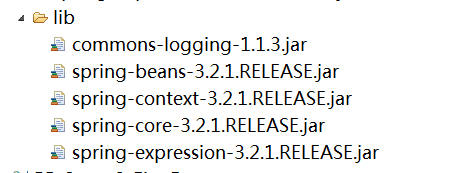Spring核心概念之Ioc
一、初识Spring之Ioc
Spring是一个轻量级的企业级开源框架,Spring框架的核心是一个Ioc容器。
Ioc (Inversion of Control)又称"控制反转",是面向对象编程中的一种设计原则,用来降低程序代码之间的耦合度。
实战演练:使用Spring Ioc实现业务层和数据访问层解耦合。
1.定义数据访问层接口:UserDao
package com.jbit.fsd.dao;
import java.util.List;
import com.jbit.fsd.entity.User;
public interface UserDao {
public List<User> getAll();
}
2.定义了业务访问层接口:UserService
package com.jbit.fsd.service;
import java.util.List;
import com.jbit.fsd.entity.User;
public interface UserService {
public List<User> getAll();
}
3.定义了数据访问层接口实习类:UserDaoImpl
package com.jbit.fsd.dao.impl;
import java.util.ArrayList;
import java.util.List;
import com.jbit.fsd.dao.UserDao;
import com.jbit.fsd.entity.User;
public class UserDaoImpl implements UserDao {
@Override
public List<User> getAll() {
//操作数据库读到所有数据
List<User> list=new ArrayList<User>();
list.add(new User());
list.add(new User());
list.add(new User());
return list;
}
}
4.定义数据访问层接口实现类:UserServiceImpl
package com.jbit.fsd.service.impl;
import java.util.List;
import com.jbit.fsd.dao.UserDao;
import com.jbit.fsd.entity.User;
import com.jbit.fsd.service.UserService;
public class UserServiceImpl implements UserService{
private UserDao dao;
//通过spring注入进来
public void setDao(UserDao dao) {
this.dao = dao;
}
@Override
public List<User> getAll() {
// TODO Auto-generated method stub
return dao.getAll();
}
}
5.在spring配置文件中配置Bean并注入业务实现类UserServiceImpl
<?xml version="1.0" encoding="UTF-8"?> <beans xmlns="http://www.springframework.org/schema/beans" xmlns:xsi="http://www.w3.org/2001/XMLSchema-instance" xmlns:aop="http://www.springframework.org/schema/aop" xmlns:tx="http://www.springframework.org/schema/tx" xsi:schemaLocation=" http://www.springframework.org/schema/beans http://www.springframework.org/schema/beans/spring-beans-2.5.xsd http://www.springframework.org/schema/aop http://www.springframework.org/schema/aop/spring-aop-2.5.xsd http://www.springframework.org/schema/tx http://www.springframework.org/schema/tx/spring-tx-2.5.xsd"> <!-- 以面向接口思想编程实现解耦和 -->
<!-- class为bean的全类名,通过反射在IOC容器中创建bean,所有要求bean中必须有无参的构造方法 --> <bean id="userDao" class="com.jbit.fsd.dao.impl.UserDaoImpl"> </bean> <bean id="userServiceImpl" class="com.jbit.fsd.service.impl.UserServiceImpl"> <!-- 需要注意是是这里调用setDao()方法 --> <property name="dao" ref="userDao"></property> <!-- 属性注入 --> </bean> </beans>
6.测试类入口:package com.jbit.fsd.test;
import java.util.List;
import org.springframework.context.ApplicationContext;
import org.springframework.context.support.ClassPathXmlApplicationContext;
import com.jbit.fsd.dao.UserDao;
import com.jbit.fsd.entity.User;
import com.jbit.fsd.service.UserService;
public class Test {
/**
*
* Description:
* @param
* @author xiazhongwei
* @data 2016:下午12:18:37
* @return
*/
public static void main(String[] args) {
ApplicationContext ac=new ClassPathXmlApplicationContext("applicationContext.xml");
UserService service=(UserService) ac.getBean("userServiceImpl");
List<User> list=service.getAll();
System.out.println(list.size()+"********************");
}
}
加载Spring配置文件亦可以使用BeanFactory:
Rosource resource = new ClassPathResource("applicationContext.xml");
BeanFactory factory = new XmlBeanFactory(resource);
factory.getBean("id",Class);//根据名字和类型查找
上面的小例子需要Spring核心jar的支持:可到官网下载:
spring-core.xxx.jar
spring-beans-xxx.jar
commons-logging.xxx.jar
如果使用ApplicationContext加载配置文件需要
spring-context.xxx.jar
spring-expression.xxx.jar

说明:
1.Spring为dao属性赋值是通过setDao()方法实现的,而非直接为dao属性赋值,若属性为dao,但是setter方法为setUserDao,Spring配置文件应该写成name="userDao",而非name="dao",是用了反射机制Class.forName(class).newInstance(),为接口注入实现类;
2.除了使用ApplicationContext及其实现类,还可以通过BeanFactory接口实现类对Bean组件实施管理,ApplicationContext建立在BeanFactory的基础之上,可以对企业级开发提供更全名的支持。
使用上面的方法通过spring的setter访问器实现对属性的赋值,这种方法称设置注入,除此之外,spring还提供了通过构造方法赋值,这种称构造注入。
定义业务实现类UserServiceImplByConstructor
package com.jbit.fsd.service.impl;
import java.util.List;
import com.jbit.fsd.dao.UserDao;
import com.jbit.fsd.entity.User;
import com.jbit.fsd.service.UserService;
public class UserServiceImplByConstructor implements UserService {
private UserDao dao;
// 定义有参的构造方法JVM不会自定义无参的构造方法,需要手动加入
public UserServiceImplByConstructor(){
}
// 用于为dao属性赋值的构造方法
public UserServiceImplByConstructor(UserDao dao){
this.dao = dao;
}
@Override
public List<User> getAll() {
return dao.getAll();
}
}
spring配置文件中的配置:
<?xml version="1.0" encoding="UTF-8"?> <!-- - Application context definition for JPetStore's business layer. - Contains bean references to the transaction manager and to the DAOs in - dataAccessContext-local/jta.xml (see web.xml's "contextConfigLocation"). --> <beans xmlns="http://www.springframework.org/schema/beans" xmlns:xsi="http://www.w3.org/2001/XMLSchema-instance" xmlns:aop="http://www.springframework.org/schema/aop" xmlns:tx="http://www.springframework.org/schema/tx" xsi:schemaLocation=" http://www.springframework.org/schema/beans http://www.springframework.org/schema/beans/spring-beans-2.5.xsd http://www.springframework.org/schema/aop http://www.springframework.org/schema/aop/spring-aop-2.5.xsd http://www.springframework.org/schema/tx http://www.springframework.org/schema/tx/spring-tx-2.5.xsd"> <!-- 以面向接口思想编程实现解耦和 --> <bean id="userDao" class="com.jbit.fsd.dao.impl.UserDaoImpl"> </bean> <bean id="userServiceImplByConstructor" class="com.jbit.fsd.service.impl.UserServiceImplByConstructor"> <!-- 通过定义的单参数构造为业务层的dao属性赋值 --> <constructor-arg> <!-- 引用id为userDao的对象为dao属性赋值 --> <ref bean="userDao"/> </constructor-arg> </bean> </beans>
说明:一个<constructor-arg>元素表示一个构造参数,且使用时不区分顺序,当构造方法的参数出现混淆,无法区分时,可以通过<constructor-arg>元素的index属性来指定该参数的位置索引,位置从0开始,<constructor-arg>元素还提供了type属性用来指定参数的类型,避免字符串和基本类型的混淆。
抽象Bean的定义:
如果定义bean的属性abstract属性为true的bean,这样的bean不能被IOC容器实例化,只用来被继承配置。若一个bean的class属性没有指定,那么该bean必须是一个抽象bean。
bean配置的继承:使用bean的parent属性指定继承那个bean的配置。并不是bean元素里的所有属性都会被继承,比如:autowire,abstract等。Spring允许通过depends-on属性设置Bean的前置依赖Bean,会在本bean实例化之前创建好,如果有多个依赖bean可以使用逗号分开配置bean的名称。
<?xml version="1.0" encoding="UTF-8"?> <beans xmlns="http://www.springframework.org/schema/beans" xmlns:xsi="http://www.w3.org/2001/XMLSchema-instance" xmlns:util="http://www.springframework.org/schema/util" xmlns:p="http://www.springframework.org/schema/p" xsi:schemaLocation="http://www.springframework.org/schema/beans http://www.springframework.org/schema/beans/spring-beans.xsd http://www.springframework.org/schema/util http://www.springframework.org/schema/util/spring-util-4.0.xsd"> <!-- 配置一个 bean --> <bean id="helloWorld" class="com.atguigu.spring.helloworld.HelloWorld"> <!-- 为属性赋值 --> <property name="user" value="Jerry"></property> </bean> <!-- 配置一个 bean --> <bean id="helloWorld2" class="com.atguigu.spring.helloworld.HelloWorld"> <!-- 为属性赋值 --> <!-- 通过属性注入: 通过 setter 方法注入属性值 --> <property name="user" value="Tom"></property> </bean> <!-- 通过构造器注入属性值 --> <bean id="helloWorld3" class="com.atguigu.spring.helloworld.HelloWorld"> <!-- 要求: 在 Bean 中必须有对应的构造器. --> <constructor-arg value="Mike"></constructor-arg> </bean> <!-- 若一个 bean 有多个构造器, 如何通过构造器来为 bean 的属性赋值 --> <!-- 可以根据 index 和 value 进行更加精确的定位. (了解) --> <bean id="car" class="com.atguigu.spring.helloworld.Car"> <constructor-arg value="KUGA" index="1"></constructor-arg> <constructor-arg value="ChangAnFord" index="0"></constructor-arg> <constructor-arg value="250000" type="float"></constructor-arg> </bean> <bean id="car2" class="com.atguigu.spring.helloworld.Car"> <constructor-arg value="ChangAnMazda"></constructor-arg> <!-- 若字面值中包含特殊字符, 则可以使用 DCDATA 来进行赋值. (了解) --> <constructor-arg> <value><![CDATA[<ATARZA>]]></value> </constructor-arg> <constructor-arg value="180" type="int"></constructor-arg> </bean> <!-- 配置 bean --> <bean id="dao5" class="com.atguigu.spring.ref.Dao"></bean> <bean id="service" class="com.atguigu.spring.ref.Service"> <!-- 通过 ref 属性值指定当前属性指向哪一个 bean! --> <property name="dao" ref="dao5"></property> </bean> <!-- 声明使用内部 bean --> <bean id="service2" class="com.atguigu.spring.ref.Service"> <property name="dao"> <!-- 内部 bean, 类似于匿名内部类对象. 不能被外部的 bean 来引用, 也没有必要设置 id 属性 --> <bean class="com.atguigu.spring.ref.Dao"> <property name="dataSource" value="c3p0"></property> </bean> </property> </bean> <bean id="action" class="com.atguigu.spring.ref.Action"> <property name="service" ref="service2"></property> <!-- 设置级联属性(了解) --> <property name="service.dao.dataSource" value="DBCP2"></property> </bean> <bean id="dao2" class="com.atguigu.spring.ref.Dao"> <!-- 为 Dao 的 dataSource 属性赋值为 null, 若某一个 bean 的属性值不是 null, 使用时需要为其设置为 null(了解) --> <property name="dataSource"><null/></property> </bean> <!-- 装配集合属性 --> <bean id="user" class="com.atguigu.spring.helloworld.User"> <property name="userName" value="Jack"></property> <property name="cars"> <!-- 使用 list 元素来装配集合属性 --> <list> <ref bean="car"/> <ref bean="car2"/> </list> </property> </bean> <!-- 声明集合类型的 bean --> <util:list id="cars"> <ref bean="car"/> <ref bean="car2"/> </util:list> <bean id="user2" class="com.atguigu.spring.helloworld.User"> <property name="userName" value="Rose"></property> <!-- 引用外部声明的 list --> <property name="cars" ref="cars"></property> </bean> <bean id="user3" class="com.atguigu.spring.helloworld.User" p:cars-ref="cars" p:userName="Titannic"></bean> <!-- bean 的配置能够继承吗 ? 使用 parent 来完成继承 --> <bean id="user4" parent="user" p:userName="Bob"></bean> <bean id="user6" parent="user" p:userName="维多利亚"></bean> <!-- 测试 depents-on --> <bean id="user5" parent="user" p:userName="Backham" depends-on="user6"></bean> </beans>
二、不同类型参数的注入方法
1.注入直接量(基本类型、字符串)
<?xml version="1.0" encoding="UTF-8"?> <!-- - Application context definition for JPetStore's business layer. - Contains bean references to the transaction manager and to the DAOs in - dataAccessContext-local/jta.xml (see web.xml's "contextConfigLocation"). --> <beans xmlns="http://www.springframework.org/schema/beans" xmlns:xsi="http://www.w3.org/2001/XMLSchema-instance" xmlns:aop="http://www.springframework.org/schema/aop" xmlns:tx="http://www.springframework.org/schema/tx" xsi:schemaLocation=" http://www.springframework.org/schema/beans http://www.springframework.org/schema/beans/spring-beans-2.5.xsd http://www.springframework.org/schema/aop http://www.springframework.org/schema/aop/spring-aop-2.5.xsd http://www.springframework.org/schema/tx http://www.springframework.org/schema/tx/spring-tx-2.5.xsd"> <!-- 以面向接口思想编程实现解耦和 --> <bean id="userDao" class="com.jbit.fsd.dao.impl.UserDaoImpl"> </bean> <bean id="userServiceImpl" class="com.jbit.fsd.service.impl.UserServiceImpl"> <!-- 需要注意是是这里调用setDao()方法 --> <property name="dao" ref="userDao"></property> <!-- 属性注入 --> </bean> <bean id="userServiceImpl" class="com.jbit.fsd.service.impl.UserServiceImpl"> <property name="username"> </property> <!-- 注入直接量 --> <value>张三</value> </bean> <bean id="userServiceImpl" class="com.jbit.fsd.service.impl.UserServiceImpl"> <!-- 需要注意是是这里调用setDao()方法 --> <property name="dao"> <ref local="userDao"></ref> </property> </bean> <bean id="userServiceImplByConstructor" class="com.jbit.fsd.service.impl.UserServiceImplByConstructor"> <!-- 通过定义的单参数构造为业务层的dao属性赋值 --> <constructor-arg> <!-- 引用id为userDao的对象为dao属性赋值 --> <ref bean="userDao"/> </constructor-arg> </bean> </beans>
上面的代码看:local属性和bean属性的用法和像,区别在于:当把spring的配置文件拆分为多个时,使用local属性只能在同一个配文件中检索Bean的id,而使用bean属性可以在其他配置文件中检索id。
2.使用内部Bean
<bean id="userServiceImpl" class="com.jbit.fsd.service.impl.UserServiceImpl">
<!-- 需要注意是是这里调用setDao()方法 -->
<property name="dao" >
<bean class="com.pb.dao.impl.UserDaoimpl">
</property> <!-- 属性注入 -->
</bean>
如果属性中包含特殊字符如(&,<,>)等可将特殊字符替换为实体引用,如<替换为&It.
3.注入集合类型的属性
<?xml version="1.0" encoding="UTF-8"?> <beans xmlns="http://www.springframework.org/schema/beans" xmlns:xsi="http://www.w3.org/2001/XMLSchema-instance" xmlns:aop="http://www.springframework.org/schema/aop" xmlns:tx="http://www.springframework.org/schema/tx" xsi:schemaLocation=" http://www.springframework.org/schema/beans http://www.springframework.org/schema/beans/spring-beans-2.5.xsd http://www.springframework.org/schema/aop http://www.springframework.org/schema/aop/spring-aop-2.5.xsd http://www.springframework.org/schema/tx http://www.springframework.org/schema/tx/spring-tx-2.5.xsd"> <!-- 以面向接口思想编程实现解耦和 --> <bean id="userDao" class="com.jbit.fsd.dao.impl.UserDaoImpl"> </bean> <bean id="user" class="com.pb.eneity.User"> <property name="hobbies">
<!--list类型变量的注入 --> <list> <value>足球</value> <value>篮球</value> </list> </property> </bean> <bean id="user" class="com.pb.eneity.User"> <property name="hobbies">
<!--ser类型变量的注入--> <set> <value>足球</value> <value>篮球</value> </set> </property> </bean> <bean id="user" class="com.pb.eneity.User"> <property name="hobbies">
<!-- map类型变量的注入 --> <map> <entry> <key><value>username</value></key> <ref bean="com.pb.entity.User"></ref> </entry> </map> </property> </bean> </beans>
三、使用多种方式简化spring Ioc的配置
1.使用p命名空间注入Bean属性
使用p命名空间改进配置,改进前先添加p命名空间是声明。
<?xml version="1.0" encoding="UTF-8"?> <!-- - Application context definition for JPetStore's business layer. - Contains bean references to the transaction manager and to the DAOs in - dataAccessContext-local/jta.xml (see web.xml's "contextConfigLocation"). --> <beans xmlns="http://www.springframework.org/schema/beans" xmlns:xsi="http://www.w3.org/2001/XMLSchema-instance" xmlns:aop="http://www.springframework.org/schema/aop" xmlns:tx="http://www.springframework.org/schema/tx" xmlns:aop="http://www.springframework.org/schema/p" xsi:schemaLocation=" http://www.springframework.org/schema/beans http://www.springframework.org/schema/beans/spring-beans-2.5.xsd http://www.springframework.org/schema/aop http://www.springframework.org/schema/aop/spring-aop-2.5.xsd http://www.springframework.org/schema/tx http://www.springframework.org/schema/tx/spring-tx-2.5.xsd"> <bean id="userDao" class="com.jbit.fsd.dao.impl.UserDaoImpl" p:age="18" p:username="xiaoming"> </bean> </beans>
使用p命名空间简化配对效果明显,使用语法总结:
1.对于直接量(基本数据类型、字符串)属性,使用方式如下:
p:属性名=“属性值”
2.对于引用Bean的属性,使用方式如下:
p:属性名-ref="Bean的id"
2.Spring配置文件实现自动装配
<bean>元素的autowire属性提供了一种自动注入的依赖对象的机制,配置Bean时不需要做任何显示的指定,spring会自动查找符合条件的依赖对象并实施注入。
<bean id="userService" class="com.pb.serviceImp.UserServiceImpl" autowire="byType">
spring提供了几种自动装配的类型:
1.no:默认值,Spring默认不进行自动装配,必须显示的指定依赖对象
2.byName: 根据属性名自动装配,Spring自动查找与属性名相同的id,如果找到,则自动注入,否则什么也不做。
3.byType:根据属性的类型自动装配,Spring自动查找与属性类型相同Bean,如果找到唯一的那个,则自动注入,如果找到多个与属性类型相同的Bean,则抛出异常,如果没找到则什么也不做。
4.constructor:和byType类似,不过他针对构造方法,如果spring找到一个Bean和构造方法的参数类型像匹配,则通过构造方法注入到依赖对象,如果没有,则抛异常。
如果每个Bean都设置autowire属性也是挺麻烦的,spring提供了default-autowire属性,设置全局的自动装配。
<beans xmlns="http://www.springframework.org/schema/beans" xmlns:xsi="http://www.w3.org/2001/XMLSchema-instance" xmlns:aop="http://www.springframework.org/schema/aop" xmlns:tx="http://www.springframework.org/schema/tx" xmlns:aop="http://www.springframework.org/schema/p" xsi:schemaLocation=" http://www.springframework.org/schema/beans http://www.springframework.org/schema/beans/spring-beans-2.5.xsd http://www.springframework.org/schema/aop http://www.springframework.org/schema/aop/spring-aop-2.5.xsd http://www.springframework.org/schema/tx http://www.springframework.org/schema/tx/spring-tx-2.5.xsd" default-autowire="byType">



